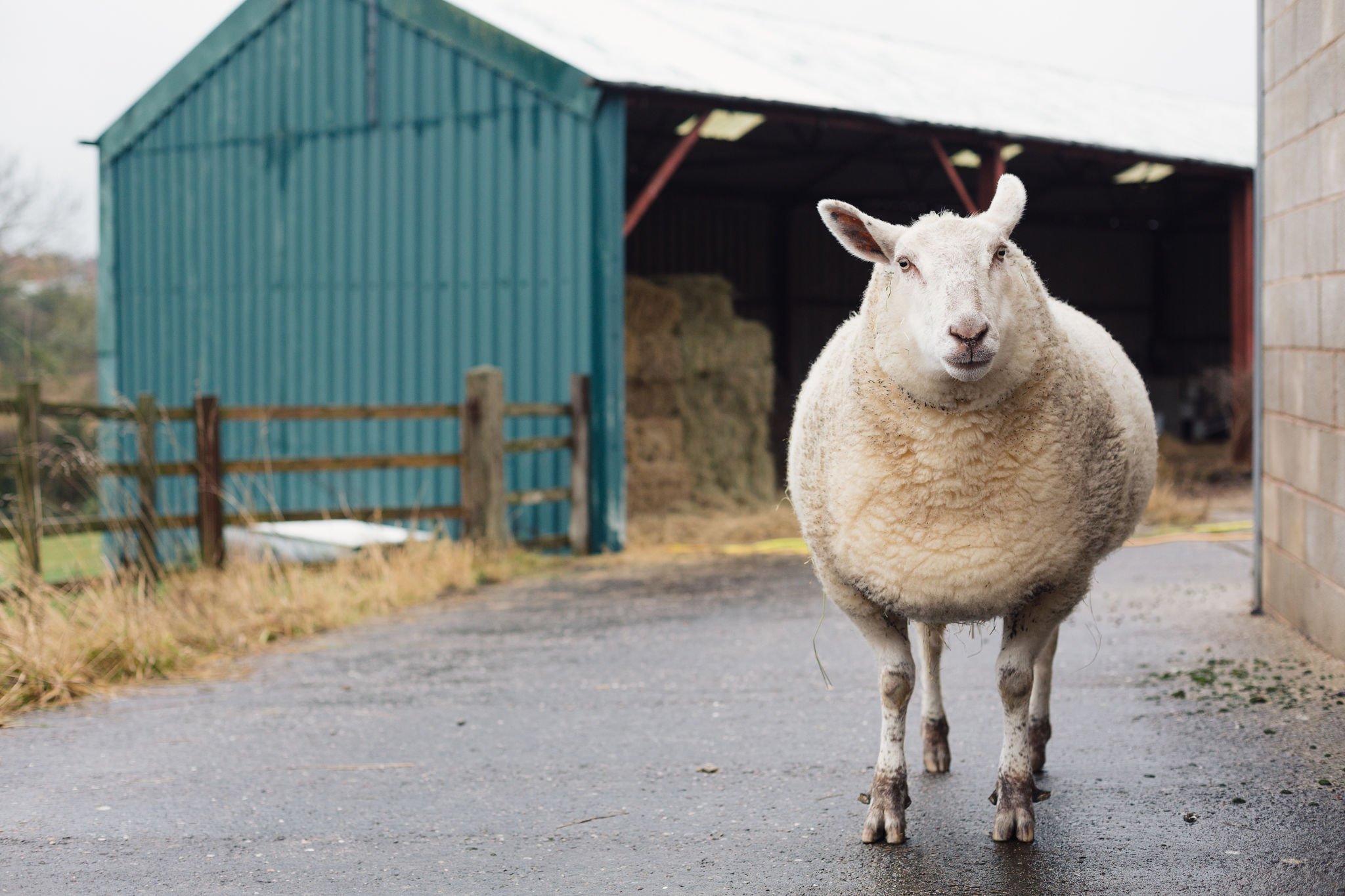Shearing: what do vegan sanctuaries do with the wool?
Eric the sheep at the Surge Sanctuary, with a very tidy coat of wool indeed. Photo: Tom Woollard.
Farmed sheep have been bred over generations to produce so much wool that they can’t shed enough of it naturally, meaning that many need to be sheared by humans to avoid unpleasant health problems. But what sanctuaries then do with that wool can differ wildly. We discuss the issues surrounding wool production and what we and other sanctuaries do with our residents’ excess wool.
One could think that buying wool or products made out of wool is not that bad. Sheep grow wool and need to be sheared but not murdered for this, right? Unfortunately, the wool industry is just as cruel as any other industry that involves animal exploitation such as the dairy, meat or leather industry.
Naturally, sheep grow exactly the amount of wool they need for their own protection against extreme temperature. Wild sheep such as the Rocky Mountain Bighorn Sheep, Dall Sheep and Stone Sheep are still perfectly fine without being sheared. But the sheep we see grazing on hillsides have been bred to grow up to 30 pounds (14kg) of wool per year depending on the breed.
Shearers are paid by yield, therefore they try to shear as many sheep as possible as fast as they can. More wool means more profit. How the sheep are treated is of no relevance at all.
The shearing process alone is very stressful for them. As prey animals, they are instinctively terrified of being pinned down. But who wouldn’t be terrified if someone pushes you down violently and comes very close with a razor to your skin? In fact, it’s not a rarity that shearers injure the sheep and only “use a needle and thread to sew the worst wounds shut—without any pain relief. Strips of skin—and even teats, tails, and ears—are often cut or ripped off during shearing” as PETA reported in one of their articles about the wool industry. Peta investigated more than 30 shearing sheds in the U.S. and Australia and uncovered horrible abuse: “Shearers were caught punching, kicking, and stomping on sheep, in addition to hitting them in the face with electric clippers and standing on their heads, necks, and hind limbs. One shearer was seen beating a lamb in the head with a hammer. Another even used a sheep’s body to wipe the sheep’s own urine off the floor. And yet another shearer repeatedly twisted and bent a sheep’s neck, breaking it.” This is just one example of the many cruelties sheep have to endure in the wool industry.
Nonetheless, there is some good news: Many sanctuaries all over the world save sheep from this horror and give them the possibility to live a happy and peaceful life, but they still need to be sheared because these sheep were still bred for excessive wool production on wool farms. At sanctuaries, this procedure is done very carefully and with no rush to avoid stressing the sheep unnecessarily. But what happens to the wool afterwards? Why don’t most sanctuaries sell the wool? Animals do not live to provide products for us. Therefore, selling the wool would mean condoning the use of animal products and that’s the opposite of what sanctuaries stand for. By selling it, sheep would once more become commodities and their life would only be of value if they produced enough wool. The same reasoning can be applied to explain why vegans don’t eat the eggs of backyard hens. If you’re interested in this topic, you can watch this video by Surge.
So, what happens to the wool that accumulates in sanctuaries? Let’s look at a few examples.
The sheep Bahty and Hope are living a wonderful life at North Mountain Animal Sanctuary in Canada. Their wool is currently being used for insulation in the newly constructed barns and shelters. All of the sanctuary’s buildings are insulated which helps to keep the animals warm in the winter time and cool during the summer months. Some wool is left in the woods, where birds such as starlings taking it every year to insulate their nests.
The seven sheep currently living at the Canadian Promised Land Animal Sanctuary are sheared once a year. Their wool is also used to insulate the barn, for residents' bedding and in the garden to keep the slugs from crawling on the tomato plants. It’s also left out for wildlife to use for their nests and shelters. Anything that is left over simply goes in the manure pile to decompose and be used as fertiliser.
At A Home for Hooves Farm Sanctuary, there are two breeds of sheep, one that needs to be sheared and one that doesn't because the wool falls out naturally. The angora goats need to be sheared as well. The wool, there too, is either composted or left out for wild birds to make nests with.
At Surge Sanctuary, the dirty wool goes on the muck pile and the rest is waiting in a wheelbarrow for Jack’s Patch to use it in the vegetable patch to hold water. Other animals at the sanctuary as well as the sheep love to use it for a comfy bed and wild birds take it for their nests, too.
As for humans, we don’t even need wool. There are many other materials we can use to keep us warm without exploiting and hurting sheep like hemp, tencel, soybean cashmere, bamboo or organic cotton.


